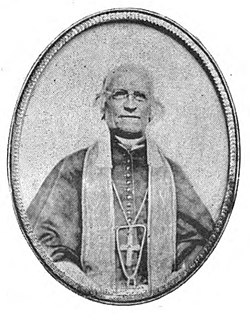
Dubuque is the county seat of Dubuque County, Iowa, United States, located along the Mississippi River. At the time of the 2020 census, the population of Dubuque was 59,667.

Dubuque County is a county located in the U.S. state of Iowa. As of the 2020 census, the population was 99,266, making it the eighth-most populous county in Iowa. The county seat is Dubuque. The county is named for Julien Dubuque, the first European settler of Iowa.

Éliphas Lévi Zahed, born Alphonse Louis Constant, was a French esotericist, poet, and author of more than twenty books about magic, Kabbalah, alchemical studies, and occultism. He pursued an ecclesiastical career in the Catholic Church until, after great personal struggle, at the age of 26, he abandoned the Roman Catholic priesthood. At the age of 40 he started to profess a knowledge of the occult, also becoming a reputed ceremonial magician.

USS Dubuque (LPD-8), an Austin-class amphibious transport dock, is the second ship of the United States Navy to be named for the city of Dubuque, Iowa.

Salvador Edward Luria was an Italian microbiologist, later a naturalized U.S. citizen. He won the Nobel Prize in Physiology or Medicine in 1969, with Max Delbrück and Alfred Hershey, for their discoveries on the replication mechanism and the genetic structure of viruses. Salvador Luria also showed that bacterial resistance to viruses (phages) is genetically inherited.

Mathias Loras was an immigrant French priest to the United States and the first bishop of the Dubuque Diocese in what would become the state of Iowa.

Sylvain Lévi was an influential French orientalist and indologist who taught Sanskrit and Indian religion at the École pratique des hautes études.
Yusuf Rahim, better known as Levi Bellfield, is an English serial killer and sex offender. He was found guilty on 25 February 2008 of the murders of Marsha McDonnell and Amélie Delagrange and the attempted murder of Kate Sheedy, and sentenced to life imprisonment. On 23 June 2011, Bellfield was further found guilty of the murder of Milly Dowler.

Alexander D'Arcy was an Egyptian stage, television and film actor with an international film repertoire.

Christ Stopped at Eboli, also known as Eboli in the United States, is a 1979 drama film directed by Francesco Rosi, adapted from the book of the same name by Carlo Levi. It stars Gian Maria Volonté as Levi, a political dissident under Fascism who was exiled in the Basilicata region in Southern Italy.
Levi or Lévi is a Jewish surname. It is a transliteration of the Hebrew word לוי meaning "attached" or "joining". Another spelling of the name is Levy. According to Jewish tradition, people with the surname are Levites who can claim patrilineal descent from the Leviim of biblical times. In 2019, it was revealed as the second most common surname in Israel.

The Mines of Spain State Recreation Area and E. B. Lyons Nature Center is a state park in Dubuque County, Iowa, United States. It is near Dubuque, the eighth-largest city in the state. The park features picnic areas, 15 miles (24 km) of walking/hiking trails, 4 miles (6.4 km) of ski trails, and the Betty Hauptli Bird and Butterfly Garden. It also includes archaeological sites of national importance as an early lead mining and smelting venture led by French explorer Julien Dubuque, as well as Dubuque's gravesite. These sites were collectively designated a National Historic Landmark District as Julien Dubuque's Mines.

Claude Lévi-Strauss was a French anthropologist and ethnologist whose work was key in the development of the theories of structuralism and structural anthropology. He held the chair of Social Anthropology at the Collège de France between 1959 and 1982, was elected a member of the Académie française in 1973 and was a member of the School for Advanced Studies in the Social Sciences in Paris. He received numerous honors from universities and institutions throughout the world.

Alexandre Ivanovich Dubuque, also Alexander and Dubuc, was a 19th-century Russian pianist, composer and teacher of French descent.

Jean-Antoine-Marie Pelamourgues (1811–1875) was a French missionary who was one of the first Roman Catholic priests to serve in the Diocese of Dubuque in the state of Iowa. He served as the first pastor of St. Anthony's Church in Davenport, Iowa from 1839 to 1868.
Carl Waino Alexander Linder was a Finnish-American long-distance runner. He competed in the marathon at the 1920 Summer Olympics. One year earlier, he won the Boston Marathon.

Mount Saint Bernard Seminary and Barn are historic buildings located south of Dubuque, Iowa, United States. Bishop Mathias Loras, the first Bishop of Dubuque, founded the a Catholic institution of higher education in his residence in 1839. St. Raphael's Seminary, primarily for the education of priests, was probably the first college established in what would become the State of Iowa. The Brothers of Christian Instruction, a French teaching order recruited to the diocese of Loras, contributed their services to the seminary. The school was expanded in 1850 when he began the construction of three new buildings on Table Mound that he named Mount St. Bernard College and Seminary. The Rev. Andrew Trevis, who was later influential in the development of Sacred Heart Cathedral in Davenport, was the rector at the time the building was constructed. The three-story limestone combination Federal and Greek Revival structure was designed by local architect Hugh V. Gildea. It was built for $10,000, which was a lot of money for the diocese at that time. It is unknown when the frame, gable-roofed barn with a stone foundation was built.
Levi Jefferson Ham was an American politician and surgeon.














